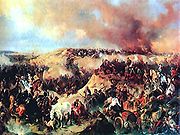
Alexander Kotzebue
Encyclopedia
Alexander Friedrich Wilhelm Franz von Kotzebue (Russian
Александр Евстафиевич Коцебу - Alexander Ewstafijewitsch Kotzebu ; 9 June 1815, Königsberg
- 24 August 1889, Munich
) was a German-Russian Romantic
painter of historical scenes
and battle scenes.
 Alexander von Kotzebue was the son of the playwright August von Kotzebue
Alexander von Kotzebue was the son of the playwright August von Kotzebue
. On August's death in 1819, Alexander was educated in the Cadet Corps in St Petersburg, leaving it in 1834 as a Gardeleutnant. However, four years later, in 1838, he moved to an artistic career and began his artistic training at the St Petersburg Academy under Alexander Sauerweid. He spent six years at the St Petersburg Academy and at the end of them, in 1844, exhibited his first painting, The Storming of Warsaw, in St Petersburg.
He then went to continue his studies in Paris in 1846 and to Belgium, the Netherlands, Italy and Germany in 1848, before finally settling in Munich. There he became imperial professor of Russian and an honorary member of the Academy of Fine Arts Munich. He painted several large-scale works for the Russian tsar of Russian battles in the Seven Years' War
and the campaigns of Alexander Suvorov
. The most important of these are considered to be the Storming of Schlüsselburg, Battle of Poltawa, Storming of Narva, Crossing of the Devil's Bridge and Founding of St Petersburg (Maximilianeum
, Munich). Kotzebue is buried in Munich's Alter Südfriedhof
.
Russian language
Russian is a Slavic language used primarily in Russia, Belarus, Uzbekistan, Kazakhstan, Tajikistan and Kyrgyzstan. It is an unofficial but widely spoken language in Ukraine, Moldova, Latvia, Turkmenistan and Estonia and, to a lesser extent, the other countries that were once constituent republics...
Александр Евстафиевич Коцебу - Alexander Ewstafijewitsch Kotzebu ; 9 June 1815, Königsberg
Königsberg
Königsberg was the capital of East Prussia from the Late Middle Ages until 1945 as well as the northernmost and easternmost German city with 286,666 inhabitants . Due to the multicultural society in and around the city, there are several local names for it...
- 24 August 1889, Munich
Munich
Munich The city's motto is "" . Before 2006, it was "Weltstadt mit Herz" . Its native name, , is derived from the Old High German Munichen, meaning "by the monks' place". The city's name derives from the monks of the Benedictine order who founded the city; hence the monk depicted on the city's coat...
) was a German-Russian Romantic
Romanticism
Romanticism was an artistic, literary and intellectual movement that originated in the second half of the 18th century in Europe, and gained strength in reaction to the Industrial Revolution...
painter of historical scenes
History painting
History painting is a genre in painting defined by subject matter rather than an artistic style, depicting a moment in a narrative story, rather than a static subject such as a portrait...
and battle scenes.
Life

August von Kotzebue
August Friedrich Ferdinand von Kotzebue was a German dramatist.One of Kotzebue's books was burned during the Wartburg festival in 1817. He was murdered in 1819 by Karl Ludwig Sand, a militant member of the Burschenschaften...
. On August's death in 1819, Alexander was educated in the Cadet Corps in St Petersburg, leaving it in 1834 as a Gardeleutnant. However, four years later, in 1838, he moved to an artistic career and began his artistic training at the St Petersburg Academy under Alexander Sauerweid. He spent six years at the St Petersburg Academy and at the end of them, in 1844, exhibited his first painting, The Storming of Warsaw, in St Petersburg.
He then went to continue his studies in Paris in 1846 and to Belgium, the Netherlands, Italy and Germany in 1848, before finally settling in Munich. There he became imperial professor of Russian and an honorary member of the Academy of Fine Arts Munich. He painted several large-scale works for the Russian tsar of Russian battles in the Seven Years' War
Seven Years' War
The Seven Years' War was a global military war between 1756 and 1763, involving most of the great powers of the time and affecting Europe, North America, Central America, the West African coast, India, and the Philippines...
and the campaigns of Alexander Suvorov
Alexander Suvorov
Alexander Vasilyevich Suvorov , Count Suvorov of Rymnik, Prince in Italy, Count of the Holy Roman Empire , was the fourth and last generalissimo of the Russian Empire.One of the few great generals in history who never lost a battle along with the likes of Alexander...
. The most important of these are considered to be the Storming of Schlüsselburg, Battle of Poltawa, Storming of Narva, Crossing of the Devil's Bridge and Founding of St Petersburg (Maximilianeum
Maximilianeum
The Maximilianeum, a palatial building in Munich, was built as the home of a gifted students' foundation and has also housed the Bavarian Landtag since 1949.The principal was King Maximilian II of Bavaria, who started the project in 1857...
, Munich). Kotzebue is buried in Munich's Alter Südfriedhof
Alter Südfriedhof
The Alter Südfriedhof is a cemetery in Munich, Germany. It was founded by Duke Albrecht V as a plague cemetery in 1563 about half a kilometer south of the Sendlinger Gate between Thalkirchner and Pestalozzistraße.-History:...
.

